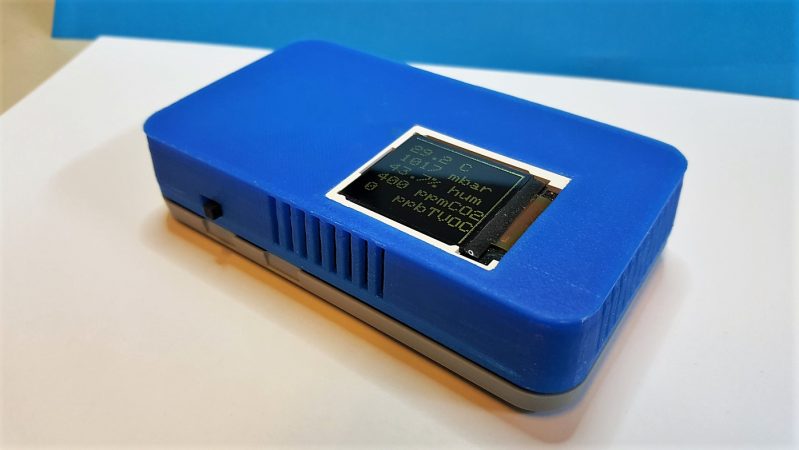To those of us in the corporate world, the conference room is where hope goes to die. Crammed into a space too small for the number of invitees, the room soon glows with radiated body heat and the aromas of humans as the time from their last shower gradually increases. To say it’s not a recipe for productivity is an understatement at best.
Having suffered through too many of these soporific situations, [Charles Ouweland] took matters into his own hands and built this portable air quality meter for meetings. With an OLED display on top and sensors inside, it displays not only the temperature, humidity, and barometric pressure, but also the CO₂ concentration and the levels of volatile organic compounds (VOC), noxious substances sometimes off-gassed from building materials, furniture upholstery, and coworkers alike.
The monitor quantifies his meeting misery, which we’re sure wins him points with his colleagues. For our part, though, what we find interesting is his design process. He started where many of us would, with an Arduino Uno. The sensor modules, a CCS811 for VOC and CO₂ as well as a BME280 for temperature, humidity, and pressure, both needed 3.3 volts, so he added a regulator to knock the Arduino’s 5-volt supply into range and some MOSFETs for level matching. Things were getting bulky, though, so he set about reducing the component count. The Uno went by stripping out its already programmed MCU. That killed the need for the regulator and MOSFETs, since everything would be happy with 3.3 volts. A few more rounds of optimization led to the final product, compact enough to run on a pair of AA batteries.
This is a great lesson in going from prototype to product. And it’s so compact, it could even ride on top of a Roomba to map the conference room’s floor-level air quality.
















“Having suffered through too many of these soporific situations, [Charles Ouweland] took matters into his own hands and built this portable air quality meter for meetings. ”
Call the EPA. Have your meeting room declared a superfund site.
Ok, I can’t resist. What does the compactness have to do with being able to run on two AA batteries?
I believe the point of this exercise was to document an example of going from proof of concept using readily available components and breakout boards, to a prototype that has only exactly what is needed.
“It’s important to recognize that the CCS811 cannot measure CO2 and that the “equivalent CO2” being reported by the CCS811 has nothing to do with actual CO2 present in the area.”
It’s not entirely true. The sensor *is* sensitive to CO2, it just can’t tell it apart from any other VOC and it has differing sensitivities to different gasses. The absolute readings of this sort of sensor is pretty much useless even when calibrated unless you’re measuring a controlled environment where the concentration of all but one gas is being measured.
Oops, I meant to say, “a controlled environment where the concentrations of all but one gas is held constant.”
They’re only really good for detecting deviation from a baseline or in a highly controlled environment.
Yes, it’s entirely true. An MOX sensor is measuring only reducing or oxidizing gasses. CO2 is neither.
The way that it is “measuring” CO2 is by proxy, from the natural carbon monoxide present in human exhalation, and the ratio of that carbon monoxide to the carbon dioxide in the same breath.
If you make the assumption that all of the carbon monoxide (a reducing gas) present in the atmosphere is from human breath, then you can infer the likely level of CO2.
Definitely a cheaper way to do it than with an NDIR CO2 sensor, though.
Yeah, gas sensors sensitive to just one thing and low power are terribly difficult to make.
Metal oxide sensors are cute and all (I led a project to develop one before), but their total lack of specficity makes them really tough to use for anything. They’re sensitive to water vapor, CO2, and basically a whole laundry list of organics, some of which are scary and some benign. They certainly have their place, but I’m definitely not sold on this whole “air quality” use.
No anemometer? Most air handling systems are designed not to create a draft at all with all of those louvers and diffusion. Make no breeze, just temp and humidity are to be “perfect” till there are suddenly more people or you’re working hard. Then let us suffer till a lot of thermal mass equalizes, um…yeah… That’s when it’s time to run a fan. More than moderate A/C requires some actual breeze for the full cooling effect and is more efficient. Cross flow fans not ceiling fans in high ceiling settings, lower height ceiling fans OK. Leave the heat up there when using A/C.
The datasheet of the CCS811 indeed speaks of equivalent CO2 (eCO2), but nowhere it says which other gases it measures as “equivalent” to CO2. Does anyone know? All I can find by google refers to Global Warming Potential (GWP), but what does a CS811 know about global warming?